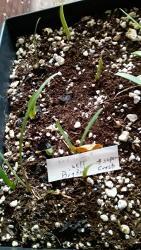WAMcCormick said:If a Red Lion self pollinates, what is the range of possibles

I have some "self-ed" Red Lions, but they are small. They may not survive the winter (see below.)
WAMcCormick, as you know, with actual winters, keeping these babies for the 3 - 7 yrs to see their flower potential means work! Taking them out each summer, and back indoors each fall. Like I said, I haven't decided who will make it back inside to survive the winter.
Although, just an hour ago I "self-pollinated" a Red Lion on my kitchen table. Who can have a blooming Hipp indoors and NOT MOVE THE POLLEN from stamen to pistil?
I certainly am no genetic expert, but nobody else is jumping in here, so....
Using my very general understanding of pollination from years of gardening and seed saving, I assume self-pollination of my Red Lion will produce offspring MOSTLY similar to it's one parent. (
https://www.britannica.com/sci...) As bsharf noted, it's been around a long time and probably stable in its traits. I also assume self-pollination (inbreeding) is "second best," with cross-pollination (out-breeding) a better bet for more seeds and better germination. I saw this when I planted my seeds of various selfs and crosses. It would also bring more diversity and perhaps vitality in offspring. Pollinating a Red Lion with a another non-clone Red Lion is a cross pollination, right?
Some of my hipps I could never successfully get to set seed regardless of being crossed or selfed by me. I've frozen the stamens before as well, and had some success using it to pollinate later blooming hipps, but my records on what pollinates and what doesn't need to be better if I'm ever going to get serious. Or, maybe I never will get serious!
Cloning your bulbs by chipping (dividing) is also a lot of fun, and gives you a replica of the parent, if your goal is to have more "just like" that one.
Good luck with your efforts.
